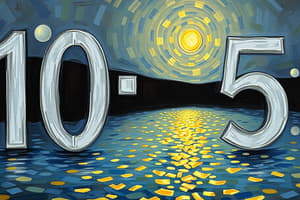Podcast
Questions and Answers
Which of the following mathematical concepts is Arhat credited with introducing, a concept vital for modern computer technology?
Which of the following mathematical concepts is Arhat credited with introducing, a concept vital for modern computer technology?
- The concept of zero (correct)
- The concept of negative numbers
- The concept of fractions
- The concept of infinity
The base of a number system determines the positional value of each digit within the number.
The base of a number system determines the positional value of each digit within the number.
True (A)
In the decimal number system, what determines the value of each digit within a number?
In the decimal number system, what determines the value of each digit within a number?
face value, base of the number system, position in the number
The rightmost digit in a number is referred to as the ______ digit.
The rightmost digit in a number is referred to as the ______ digit.
Match the number system with its corresponding base:
Match the number system with its corresponding base:
Which number system is predominantly used by digital computers to perform calculations and process data?
Which number system is predominantly used by digital computers to perform calculations and process data?
Gottfried Leibniz is credited with inventing the modern decimal number system.
Gottfried Leibniz is credited with inventing the modern decimal number system.
Before being processed by a computer, what form must data be converted into?
Before being processed by a computer, what form must data be converted into?
In the context of converting decimal numbers to binary, we repeatedly divide the decimal number by ______ until the quotient is 0.
In the context of converting decimal numbers to binary, we repeatedly divide the decimal number by ______ until the quotient is 0.
Convert the binary number 1111 (base 2) to its decimal equivalent.
Convert the binary number 1111 (base 2) to its decimal equivalent.
Hexadecimal numbers are used to represent smaller binary numbers to save space.
Hexadecimal numbers are used to represent smaller binary numbers to save space.
What digits and characters are used in the hexadecimal number system?
What digits and characters are used in the hexadecimal number system?
The octal number system has a base of ______.
The octal number system has a base of ______.
What is the decimal equivalent of the hexadecimal number 2A (base 16)?
What is the decimal equivalent of the hexadecimal number 2A (base 16)?
In binary addition, 1 + 1 equals 2.
In binary addition, 1 + 1 equals 2.
When performing binary subtraction, what is the result of 0 - 1?
When performing binary subtraction, what is the result of 0 - 1?
In the context of computer memory, 8 bits is equal to 1 ______.
In the context of computer memory, 8 bits is equal to 1 ______.
Calculate the binary sum of 1010 (base 2) + 0011 (base 2).
Calculate the binary sum of 1010 (base 2) + 0011 (base 2).
The rightmost digit is also known as the most significant digit.
The rightmost digit is also known as the most significant digit.
What are the rules for binary multiplication?
What are the rules for binary multiplication?
Flashcards
Number System
Number System
A set of values used to represent different quantities.
Who was Aryabhat?
Who was Aryabhat?
India's greatest mathematician and astronomer that introduced the concept of zero.
Decimal Number System
Decimal Number System
A numbering system with 10 digits (0 to 9) and uses base 10.
What is the base of a number system?
What is the base of a number system?
Signup and view all the flashcards
Least Significant Digit
Least Significant Digit
Signup and view all the flashcards
Most Significant Digit
Most Significant Digit
Signup and view all the flashcards
Binary Number System
Binary Number System
Signup and view all the flashcards
Who was Gottfried Leibniz?
Who was Gottfried Leibniz?
Signup and view all the flashcards
Decimal to Binary
Decimal to Binary
Signup and view all the flashcards
Binary to Decimal Conversion
Binary to Decimal Conversion
Signup and view all the flashcards
What is a byte?
What is a byte?
Signup and view all the flashcards
Octal Number System
Octal Number System
Signup and view all the flashcards
Octal to Decimal Conversion
Octal to Decimal Conversion
Signup and view all the flashcards
Hexadecimal Number System
Hexadecimal Number System
Signup and view all the flashcards
Hexadecimal to Decimal Conversion
Hexadecimal to Decimal Conversion
Signup and view all the flashcards
Computer Arithmetic
Computer Arithmetic
Signup and view all the flashcards
What is a nibble?
What is a nibble?
Signup and view all the flashcards
Binary Addition rules
Binary Addition rules
Signup and view all the flashcards
Binary Subtraction rules
Binary Subtraction rules
Signup and view all the flashcards
Binary Multiplication rules
Binary Multiplication rules
Signup and view all the flashcards
Study Notes
- In early days, people used fingers, stones, pebbles, and sticks for counting due to the lack of other means.
- Over time, various number systems were introduced to overcome the limitations of early counting methods, including decimal, binary, octal, and hexadecimal systems.
- A number system includes a set of values used to represent different quantities.
Arhat
- Arhat was India's greatest mathematician and astronomer.
- He introduced the concept of zero.
- Modern computer technology would be non-existent without the concept of zero.
Decimal Number System
- The need for counting led to the introduction of the decimal number system.
- The decimal number system uses the digits 0, 1, 2, 3, 4, 5, 6, 7, 8, and 9.
- Most arithmetic operations are performed using decimal numbers.
- The decimal number system consists of 10 digits (0 to 9) and has a base of 10.
- The base of a number system is the number of digits it uses.
- Numbers can be used individually or grouped to form a numeric value, such as 82, 256, or 52.87.
- The value of each digit depends on its face value, the base of the number system, and its position in the number.
- Each position represents a specific power of base 10.
- The rightmost digit is the least significant digit, and the leftmost digit is the most significant digit.
- The positional value of each digit increases tenfold as you move from right to left.
- Place value depends on the position of the digit in the number.
Binary Number System
- The binary number system consists of only two digits: 0 and 1.
- It has a base of 2.
- All digital computers use the binary number system
- Computers convert input data from decimal to binary format.
- Gottfried Leibniz, a German mathematician, is credited with the invention of the modern binary number system.
- Computers do not understand human language but understand binary code.
- Data entered into a computer is converted into its binary equivalent.
- The computer converts the binary results back into their decimal equivalents for output
Decimal to Binary Conversion
- Divide the decimal number by 2.
- Write down the remainder.
- Divide the quotient again by 2.
- Repeat until the quotient is 0.
- Write the remainders in reverse order to form the binary equivalent.
- Example: 25 (base 10) = 11001 (base 2)
- Example: 321 (base 10) = 101000001 (base 2)
Binary to Decimal Conversion
- Multiply each binary number with its positional value in powers of 2, starting from the rightmost digit.
- Sum up all the products to get the decimal number.
- Example: 1010 (base 2) = 0*(2^0) + 1*(2^1) + 0*(2^2) + 1*(2^3) = 0 + 2 + 0 + 8 = 10 (base 10)
- Example: 1001 (base 2) = 1*(2^0) + 0*(2^1) + 0*(2^2) + 1*(2^3) = 1 + 0 + 0 + 8 = 9 (base 10)
- Example: 110001001 (base 2) = 393 (base 10)
Bytes
- Most computer operations use the byte or multiples of bytes (16 bits, 24, 32, 64, etc.).
- Hexadecimal makes it easier to write these large binary numbers.
Octal Number System
- The octal number system consists of eight digits: 0 to 7.
- The octal number system has base 8.
- The concept of the octal number system came from Native Americans, who counted using the spaces between their fingers.
- Octal to decimal conversion is similar to binary to decimal conversion, but with a base of 8.
- To convert an octal number to decimal, multiply each digit by increasing powers of 8 from right to left, starting from zero, and sum the products.
- Example: 345 (base 8) = 3*(8^2) + 4*(8^1) + 5*(8^0) = 192 + 32 + 5 = 229 (base 10)
- Example: 317 (base 8) = 3*(8^2) + 1*(8^1) + 7*(8^0) = 192 + 8 + 7 = 207 (base 10)
Hexadecimal Number System
- Consists of 16 digits: 0 to 9 and letters A to F, where A to F represent digits 10 to 15.
- It has a base of 16.
- Hexadecimal is also known as hex (hex = 6, decimal = 10).
- Converting hexadecimal to decimal is similar to the methods used for binary and octal, but with a base of 16.
- To convert hexadecimal to decimal, multiply each digit by base 16.
- Example: 3B (base 16) = 3*(16^1) + 11*(16^0) = 48 + 11 = 59 (base 10)
- Example: 4D2 (base 16) = 4*(16^2) + 13*(16^1) + 2*(16^0) = 1024 + 208 + 2 = 1234 (base 10)
Computer Arithmetic
- Computers understand only binary code, so input data is converted to binary for processing.
- Processing includes arithmetic operations like addition, subtraction, multiplication, and division on binary numbers.
- 4 bits = 1 nibble
- 2 nibbles = 8 bits
- 8 bits = 1 byte
Binary Addition Rules
- 0 + 0 = 0
- 0 + 1 = 1
- 1 + 0 = 1
- 1 + 1 = 10 (0 with a carry-over of 1 to the next column)
- Example: 1000 (base 2) + 0111 (base 2) = 1111 (base 2)
- Example: 1111 (base 2) + 1011 (base 2) = 11010 (base 2)
Binary Subtraction Rules
- 0 - 0 = 0
- 1 - 0 = 1
- 1 - 1 = 0
- 0 - 1 = 1 (with a borrow of 1 from the next column)
- 10 - 1 = 1
- Example: 1111 (base 2) - 1010 (base 2) = 0101 (base 2)
- Example: 1100 (base 2) - 0011 (base 2) = 1001 (base 2)
Binary Multiplication Rules
- 0 * 0 = 0
- 0 * 1 = 0
- 1 * 0 = 0
- 1 * 1 = 1
- Follow the same method as decimal multiplication.
- Example: 101 (base 2) * 11 (base 2) = 1111 (base 2)
- Example: 1111 (base 2) * 11 (base 2) = 101101 (base 2)
Binary Division
- The method for dividing binary numbers is the same as for decimal numbers.
Summary of Key Points
- The decimal number system is commonly used, with base 10.
- The rightmost digit of a number is the least significant digit; the leftmost digit is the most significant digit.
- The binary number system uses digits 0 and 1, with base 2.
- The octal number system uses eight digits and has base 8.
- The hexadecimal number system uses 16 digits and has base 16.
Studying That Suits You
Use AI to generate personalized quizzes and flashcards to suit your learning preferences.




